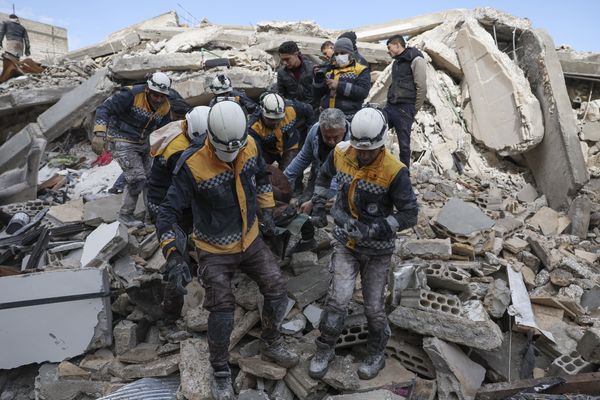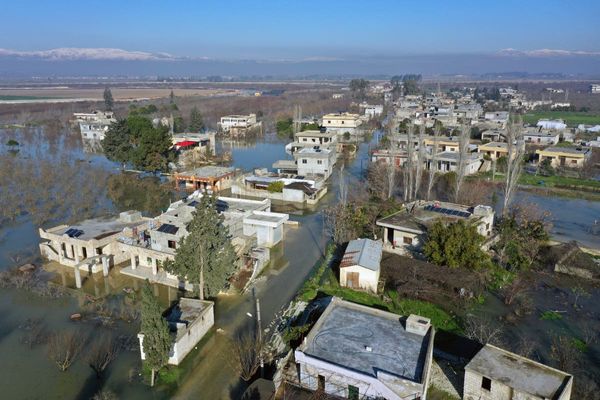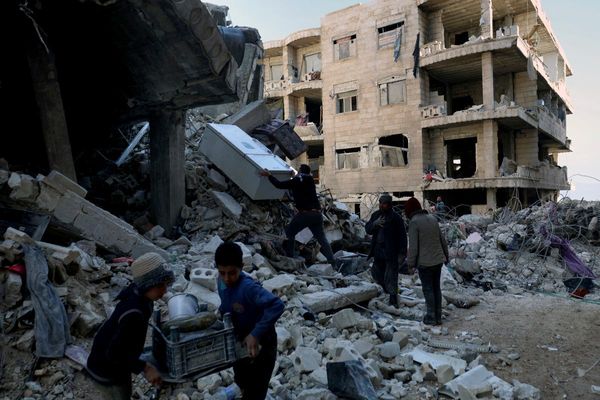
Updated at 12:30 p.m. ET on February 8, 2023
It took one of the most powerful earthquakes in a century, but the world’s attention has finally returned to Syria, a country devastated by 12 years of civil war; divided among government, militia, and foreign powers; and home to millions of internally displaced people.
So far, most of the images of the devastation have come out of Turkey, where the 7.8-magnitude quake struck early Monday morning, followed by another quake of 7.5 magnitude. Nearly 6,000 deaths have been reported there so far. Syria’s total death toll stands at about 1,900 people. But the pain of those living in the country’s rebel-held northwest, including cities such as Idlib, is particularly acute. The earthquakes came after years of ruthless bombings by Russian and Syrian government forces. Northwest Syria, where nearly 3 million internally displaced people live, is already cut off from the international community, and much of its infrastructure—including hospitals, a favorite target of Russian planes—has been completely or partially destroyed by the war. The quakes have made the plight of these Syrians unbearable.
Monday’s disaster also offers a reminder of how desperately Syria needs international aid, even if it’s hard to deliver. Although assistance is flowing into Turkey, the logistics and politics of aiding Syria, especially vulnerable areas in the northwest, are much more complicated given the ongoing conflict and the Assad regime’s pariah status in most of the international community. The Syrian and Russian governments are already seeking to politicize disaster aid by calling for an end to sanctions on the regime, and are likely to use this opportunity to try to regain control over the northwest. The United States should act quickly, and even unilaterally, to deliver aid to northern Syria while keeping Damascus’s and Moscow’s diplomatic and military moves in check.
Even before the earthquake, the Syrian and Russian governments tightly controlled the flow of aid across the border from Turkey. The Syrian government has long insisted that aid for areas controlled by opposition forces must flow through Damascus. And Russia has repeatedly vetoed United Nations efforts to increase supplies and ease their delivery to the rebel-held area via the Syrian-Turkish humanitarian corridor at the Bab-al Hawa crossing.
That road has now been wrecked by the earthquake, and the existing humanitarian supplies in the pipeline could last only three to five days. Damascus is receiving some disaster relief from Algeria, Iran, Iraq, and the United Arab Emirates, as well as from the United Nations. But no one is rushing yet to Syria’s northwest because of the challenges of reaching the area and the political obstacles. Syria’s ambassador to the UN has appealed for help from other countries and international-aid agencies while making the case that aid to the country’s northwest still should be delivered only through the Syrian government. This means that the lives of those who have fled the Syrian regime for rebel-controlled areas might again be in Bashar al-Assad’s hands. On social media, some pro-Assad accounts have been advocating against aiding the rebel areas.
Considering the scale of the earthquake damage, one could argue that the international community should allow all efforts to aid Syria—including by channeling assistance through Damascus, in exchange for which the Assad government should allow unfettered access to opposition areas via the northern border. But the Syrian regime will almost certainly resist such a move, and will delight in seeing the rebel areas suffer even more. And it will misleadingly attempt to depict the aid going to Damascus as a sign of international support for the Assad government.
Charles Lister, a senior fellow at the Middle East Institute in Washington, D.C., told me that although the Turks are understandably focused on their own rescue efforts, there are other border-crossing areas through which the United States could deliver aid to Syria’s northwest unilaterally but with Turkey’s permission or in coordination with the Kurds and other local forces. The U.S. military also has a presence in parts of northwest and northeast Syria that it could use to air-drop some aid, though this is the least ideal option given the winter weather and the lack of precision in airdrops. The military could also use its base in the northeast of the country as a hub for organizing humanitarian aid, crossing into rebel areas again in coordination with the Turks and the Kurds.
In recent months, the UAE and Jordan have made overtures to Assad, who visited Abu Dhabi last year. But the United States has resisted and warned against such a rapprochement. Since the earthquake struck, the U.S. has pledged aid to people on both sides of the border while ruling out dealing with the Assad government. The White House has yet to offer many specifics on how it will assist northwestern Syria, however. President Joe Biden said yesterday that “U.S.-supported humanitarian partners are also responding to the destruction in Syria,” a statement echoed by the State Department spokesperson. USAID Administrator Samantha Power tweeted today that she has spoken with Raed al-Saleh, the head of the Syria Civil Defence, the volunteer humanitarian group also known as the White Helmets that operates in the rebel-held area, about how USAID could provide urgent assistance to Syrians there. The White Helmets have done heroic work for years, pulling people out of the rubble of bombed-out houses, buildings, and hospitals. Their 3,000 volunteers are now deployed in full to search for survivors but are reportedly running out of fuel.
After publication of this article, a State Department spokesperson said by email, “We fully support all efforts to provide humanitarian assistance to Syrian people in need, and we are not standing in the way of those efforts. … We are working hard with our Turkish Allies and NGO partners to maintain and expand cross-border access to affected areas of Syria. We continue to work to address the damage at the Bab al-Hawa border to ensure international humanitarian aid can flow into Syria.” The spokesperson added, “Now is not the time for the regime to leverage natural disaster to their benefit.”
The logistics will be a nightmare. But the United States and the international community must push to provide immediate short-term assistance to Syrians living in opposition areas, and then think creatively about how to improve long-term prospects for Syrians without absolving the regime. If there’s one lesson from this earthquake beyond the necessity for preparedness in an area that sits on a fault line, it is that the deep wounds in this region cannot simply be cauterized and then ignored, as Washington has done with Syria. Syrians have been abandoned and forgotten for far too long already.










